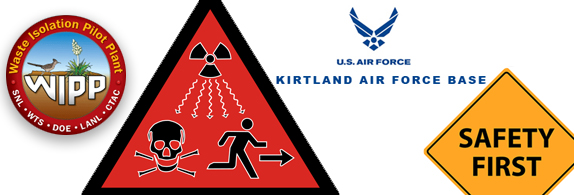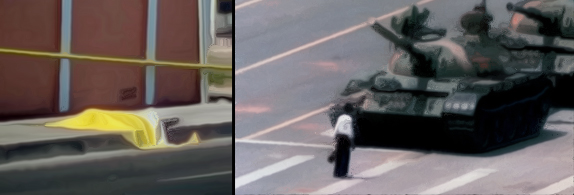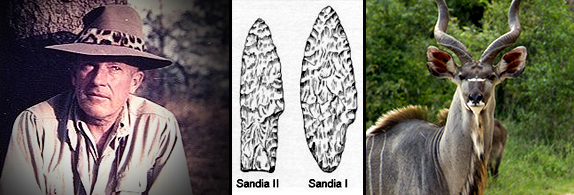WIPP, KAFB, Fail-safes and Tomfoolery

The man-made disasters that have befallen New Mexico – chief among them the Valentine’s Day radiation leak at the Waste Isolation Pilot Project (WIPP) near Carlsbad and the 24 million gallons of Air Force jet fuel polluting the aquifer near major drinking water wells in Albuquerque – seem to be a clear symptom of the fudging, fibbing, public relations spinning and truth doctoring that infects the character and culture of corporate America and the branches of government that are its clients.
The military industrial complex, like GM and other big corporations, is not operated by people who believe in the moral imperatives of the precautionary principle which is an anathema to both the military and its subcontractors. The precautionary principle says that if something is harmful, or might be harmful, or if it’s unclear if its harmful or not, then do not do it. Wait until you know. It is the core moral outlook of a culture of safety.
How could it be otherwise that the nation’s “best scientists” and “finest minds” could have allowed radiation to leak from WIPP, a nuclear waste storage facility half a mile underground? The PR around WIPP portrayed it as a failsafe facility. What a joke.
How could it be that the Air Force at Kirtland Base in Albuquerque, a city that has given so much to the military, had such a miserable inventory system its leaders couldn’t detect what is now known to be the largest jet fuel leak in the nation’s history?
Has the culture of safety in these institutions become so lackadaisical that they mirror the fantastic and terrifying safety scandals at American nuclear missile sites in recent years?
The Associated Press ran a piece in March entitled, “A look at nuclear force lapses revealed so far” that detailed “key missteps by Air Force crew members who handle the world’s deadliest weapons.” It chronicled hair-raising sloppiness and outright cheating by the officers who operate the weapons of Armageddon.
The “missteps” included two times as many court-martials in the nuclear missile force as in the rest of the Air Force, “heightened levels” of misconduct such as spousal abuse; the “embarrassing, drunken behavior” at meetings in Russia and spending time with ‘suspect’ women by the Major General in charge of the entire Minuteman 3 missile force; and worst of all, 34 nuclear missile launch officers were caught cheating on a regular test to determine if they know how to work the missile system. There are many other incidents including the failure of a security and safety inspection at a missile base in Montana and launch personnel at another site found to be asleep with the blast doors that protect their launch command center wide open.
This stuff even spooks the Air Force. Defense Secretary Chuck Hagel recently ordered an independent review of the country’s nuclear force and, the AP reports, summoned “the most senior Pentagon leaders to discuss its serious missteps, leadership lapses and personnel problems.”
I wish Secretary Hagel would summon the leadership at KAFB and find out why decades of leadership personnel didn’t have the accounting techniques, or the conscience, to keep track of 24 million gallons of jet fuel leaking into our groundwater.
Is the same lack of seriousness and responsibility displayed with our missile system undermining the operations at KAFB and at WIPP and LANL? Has the military industrial complex been so infected by the corporate culture of cover-up, stonewall and spin that it’s come to believe its own hype that nothing ever goes wrong and if it does it’s certainly not dangerous to human health and well-being?
If hardworking people in the West, like cowboys, farmers, and folks who make the oil and gas rigs work operated like that all the time half of them would be dead the first week out. They know about the dangers of nature and the orneriness of human machinery. They and their families have either developed a culture of safety to protect themselves or else they bleed out losing an arm when gloves get caught in a spinning drill bit, or have their bones crushed when trampled by a horse, or get chewed up in a combine.
Accidents happen out of the blue all the time, of course, with no human errors. But mostly people get hurt because someone isn’t paying attention and doesn’t take the work they are doing seriously enough to be careful. For those who manage to avoid major injury it’s almost always because “the precautionary principle” is at work. They know what the dangers are and they work like the dickens to avoid them because they know that once they happen it’s almost impossible to repair the damage.
Take the new hard line the city and county water authority is taking with the KAFB spill. They think that getting tough is demanding that the Air Force clean up the polluted ground water so it’s suitable for “agricultural use.” I take that to mean that it won’t be drinkable because it still has amounts of highly toxic chemicals in it. But, of course, if it’s used to grow crops chances are that the two-legged or four- legged critters that eat those crops will almost certainly be ingesting trace amounts of those chemicals, one of which, EDB or Ethylene Dibromide, once used as an anti-knock agent, is so dangerous that the EPA’s recommended safe level in water, or crops, is zero.
The spill at KAFB is so serious now that even the gentle folks at the national PBS NewsHour have run a major piece on it. I can’t wait to see if they get into the “kitty litter” scandal that’s now been proposed as one of the possible culprits in the WIPP radiation leak.
The story has it that the geniuses at LANL packed canisters containing low level plutonium waste with the wrong kind of kitty litter that not only didn’t absorb the liquid that’s not supposed to be in those canisters in the first place, but possibly caused them to explode. Has the nuclear industrial complex hired Mother Goose and the Brothers Grimm to write their PR fairytales?
The Mercury will keep you posted on the Kitty Litter scandal as events sift out.
Tyrannies Usually Have “Popular” Support

June 4th is the 25th anniversary of the Tiananmen Square democracy protests of l989 in which many hundreds of young Chinese who were speaking out for human rights and open government were massacred by Chinese troops. Like all tyrannies, large and small, the Chinese government covered up the horrors of that day with the popular acquiescence and silence of the established order.
In Albuquerque the established order is doing everything it can to close up around and hide and ignore what many people around the nation see as our city’s horrendous history of police brutality, including the almost normalized slaughter of vulnerable citizens. This denial by the city’s business leadership of what has shocked the country is a kind local tyranny, not mighty as the Chinese army, but ugly and dirty as any petty tyrant trying to get away with murder.
A couple of weeks ago, as I read about the Mary Hawkes autopsy and the new 26th police killing in Albuquerque from the perspective of the open road in Wyoming and Montana, my hometown for 56 years seemed hopeless and depressing from afar.
We’ve become synonymous, in the eyes of the national media, with drugs, violence, and a rogue police force that’s been killing the homeless and mentally ill for decades while letting the city’s crime rate escalate almost out of control.
But despite a withering report by the U.S. Department of Justice on the police department’s “culture of aggression,” and despite intense scrutiny from alternative media, internet media, national media, local television and even the Albuquerque Journal, it seems like the oligarchy, and the mayor they elected, that runs our city is working double time to brush off, cover up, and ignore what’s going on right before their eyes.
After the helmet-video of the execution style killing by police of James Boyd in the Sandia Foothills, Albuquerque’s conscience was torn open and public outrage and grief filled the city. Ever since then, the powers that be have been operating like a big wet sponge, absorbing and eventually overwhelming public outrage with airy reassurances and promises that already have been broken.
The killing of 19 year old Mary Hawkes in the International District a month ago has torn the public’s conscience open again, even though the police have failed to produce a video of the killing. The autopsy report released two weeks ago gave us all the information we needed to imagine what happened to this young woman, a person who has been eulogized as a caring and loving soul struggling with homelessness and depression. She was shot by a police officer three times, with the trajectory of the bullets on a downward path, one in the left ear, which must have killer her instantly, one in the left arm and one in the right shoulder. She also had numerous other injuries indicating the possibility of a bad beating.
The mainstream TV and print media headlined that she had been shot three times and then, in the same breath as if to excuse the shooting, they added she had meth in her system, as well as possibly other drugs, including anti-depressants. And all this brutality was directed at her because she had allegedly stolen a truck. But there must be more to this story. And I hope the conscience of the city insists that it all be brought out into the open.
The latest killing on Second Street on May 22nd involved another homeless man armed this time with a box cutter. He injured a woman, apparently, and a man who tried to breakup what looked like a terrible fight. Not much is known about this killing either, other than a police audio tape of the man telling officers to shoot him and the officers saying they didn’t want to. But then why did they? Why didn’t they use a Taser on him. He was outnumbered two to one. He had a knife with a very short hooked blade. They had guns, Tasers, and heaven’s knows what else. But no, they shot him some five or six times in the “body mass.” You’d think with the huge contracts the city has with Taser, and how its corporate presence has infiltrated City Hall with Taser spokesmen from Cincinnati doing the mayor’s negotiations with the DOJ that the police would have at least used the diabolical things and saved a life. But now another killing with endless unanswered questions. What comes next?
The photograph in the Journal of Mary Hawkes’ corpse lying on the sidewalk covered with a yellow plastic sheet with one of her feet uncovered is as traumatic to most of us in the city as the video of James Boyd being shot in the back when he agreed to abandon his illegal camp site and walk down the mountain with officers.
For teachers, Mary Hawkes could have been in any of our classrooms, a troubled kid, perhaps, but not a murderer, not an armed robber, not a gangster or a drug dealer, not a holdup artist, not a mugger, not a violent burglar. She was a kid with her life ahead of her. And where is the real gun she is supposed to have had? All we’ve seen is a “replica.” How abysmally lame is that?!
Frank Hibben - 1910 – 2002

The first time I experienced UNM archaeologist Frank Hibben lecture in a freshman anthropology class in l958, I knew instantly I wanted to be a student of human cultures past and present. He had the effortless charm of a born storyteller. And the understated humor of a standup smoothy. Learning from him as an l8-year old was a transformative moment. I went from someone who was interested mostly in girls and sports to someone whose imagination and curiosity had been ignited. Hibben was the most fascinating and engrossing lecturer I’d ever, or would ever, encounter at UNM. A performer to the core, he knew how to excite young minds.
His courtly persona, his gag lines (Where would we be without that ancient genius who invented the pocket?), his way of telling a tall tale to make a point, his ambling gait, his sky blue wool ties, his desert boots, endless font of facts -- they all added up to an irresistible aura, especially as his countenance also reflected the manners and considerations of a genuine gentleman of the old school. Some years later I had the chance to be Hibben’s grad assistant for a while and he never broke form. One on one, his stage presence took on the timely and helpful advice of a master with an apprentice. When he saw students in class not doing well, he’d try to analyze their problems and give them pointers on how to study and take tests. He wanted his students to succeed. He was that kind of teacher.
Yes, his students eventually heard about the mysterious doings at Sandia Cave about which some folks had accused him of fudging data and even salting the site with artifacts when he was fresh out of Harvard with his Ph.D. in the late l930s and early ‘40s, proclaiming Sandia Man to be 25,000 years old, far older than any ancient man remains discovered before. But to those of us who knew him, those charged innuendos seemed so preposterous we dismissed them, fairly or not, as the jealous ravings of academic cranks and never tried to unravel truth from fiction. But the accusations would neither go away nor be conclusively proved. Sandia Man disappeared from textbooks. Hibben never talked about the issue with his grad students. Somehow he sort of John Wayned his way through the whole business, brushing it off much in the same way he carried a piece of shrapnel in his back from WWII for the rest of his life.
Hibben left his fortune to UNM, a large part of it for scholarships. He created the Hibben Center for Archaeology Research and paid for the building, spent years as the founding director of the Maxwell Museum of Anthropology, played a major role in founding the Albuquerque Zoo and, as a member of the State Game Commission, imported African animals and let them loose in appropriate environments in New Mexico in hopes of stimulating the hunting economy.
Some took a dim view of his Safaris. They seemed operatic and out of sync with his role as a kindly professor and inspiring lecturer. As an old fashioned gentleman, Hibben’s portrayal as the great white hunter had a feel of a l920s movie about colonialism. But he wasn’t alone. His big game hunter persona was matched in a way by his friend and fellow sportsman the oilman and former governor Tom Bolack. Both men were Republicans of the old school – patricians made graceful by a jovial eccentricities and generous noblesse oblige. As a graduate student I had the experience of being invited to the Hibben’s house for supper, a standard practice with grads that became legendary. Like Bolack’s house in Farmington, the Hibben place on Campus Boulevard was full of stuffed animals staring down at diners. And one had to be careful not to skid on the pelts on the floor. The Hibbens served their students what one might call exotic meats such as kudu, ibex, and gemsbok. One of his practical jokes was convincing us we were eating defrosted woolly Mammoth chops snatched from the tundra of deepest Alaska.
Hibben’s many books are still available on-line including Kiva Art of the Anasazi, The Lost Americans, Prehistoric Man in Europe, Digging up America, and Hunting in Africa.
Among his excavations perhaps the most important and spectacular were the painted kivas at Pottery Mound, a site near Los Lunas which was only partially explored and then covered over for future archaeologists with new techniques and new technologies.
When you worked for Hibben, or were one of his students, you had the feeling of being looked after, of being someone who a canny old grandfather would help steer clear of major gaffs and humiliating missteps. Hibben’s care of his students was subtle, indirect, and never cloying. He kept a polished, lofty distance. Still, you always knew he had your best interests at heart, and for many of us that had a gentle, but empowering, impact.




Responses to “Provincial Matters, 6-2-2014”